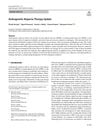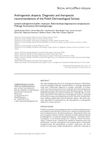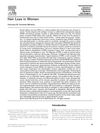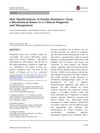How much hair growth potential can be lost due to lifestyle factors? Treatment 9/20/2025
Lifestyle factors like diet, stress, and nutrient deficiencies can impact hair regrowth, but their effects vary among individuals. Treatments mentioned include finasteride, dutasteride, and minoxidil.
View this post in the Community →
Similar Community Posts Join
6 / 1000+ resultscommunity Dutasteride Literally Saves Your Hair
Dutasteride significantly reduces scalp DHT levels and can save hair, though shedding is part of the process. Some users report success with dutasteride, while others struggle despite using it along with finasteride and oral minoxidil.
community Diagnosed with female pattern hair loss as a male with recent aggressive loss. Preemptively mourning the only part of myself I’ve ever come close to loving. Lost all motivation to do anything with my life.
The conclusion of the conversation is that the user should consider using treatments such as finasteride, minoxidil, and RU58841 to potentially reverse their hair loss. Other suggestions include using hair loss concealers and maintaining a healthy diet.
community Please can someone explain all the Dutasteride horror stories on here
Switching from finasteride to dutasteride for hair loss yields mixed results, with some users experiencing improvements and others facing worsening conditions or side effects like shedding. Patience is advised as dutasteride may take longer to show results, and combining treatments is suggested by some users.
community Coffee and androgenetic alopecia
The conversation discusses a claim that avoiding coffee can lead to significant hair regrowth in individuals with androgenetic alopecia. Participants are skeptical, with some sharing personal anecdotes that contradict the claim, and others discussing the potential role of caffeine in hair loss and the effectiveness of other treatments like finasteride and minoxidil.
community Testosterone and hair loss seeming irrelevance
The conversation is about the role of testosterone in hair loss and the effectiveness of different treatments. The conclusion is that DHT is the main culprit for hair loss, and finasteride has been proven to work long-term in maintaining and regrowing hair. Testosterone may have a minor effect, but it is not the primary cause of hair loss.
community 10 months’ hair-loss treatment progress – finasteride / dutasteride and minoxidil
User shares 10-month hair loss treatment progress using finasteride/dutasteride and minoxidil. Treatment shows positive results, with noticeable improvements in months 9 and 10.
Related Research
6 / 1000+ results
research Androgenetic Alopecia: Therapy Update
There are many treatments for common hair loss, but more trials are needed to decide which are best.

research A Pathophysiological and Clinical Review of Androgenetic, Areata, Anagen Effluvium, Telogen Effluvium, and Traction Alopecia
Understanding different types of hair loss helps in accurate diagnosis and treatment.
research An Extract of Leontopodium Alpinum Inhibits Catagen Development Ex Vivo and Increases Hair Density In Vivo
Edelweiss extract can increase hair density and promote hair growth.

research Androgenetic Alopecia: Diagnostic and Therapeutic Recommendations of the Polish Dermatological Society
Use trichoscopy to diagnose hair loss; treat with minoxidil, finasteride, or dutasteride; consider platelet-rich plasma and spironolactone.

research Hair Loss in Women: Comprehensive Overview and Treatment Options
Effective hair loss treatment in women requires correct diagnosis and can include medications like minoxidil, antiandrogens, and treatments for underlying conditions like PCOS.

research Skin Manifestations of Insulin Resistance: From a Biochemical Stance to a Clinical Diagnosis and Management
Certain skin conditions can indicate insulin resistance and should prompt lifestyle changes and medical treatment to manage underlying health issues.